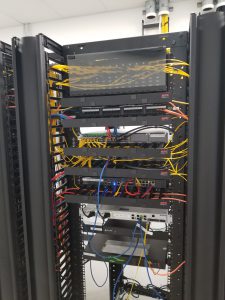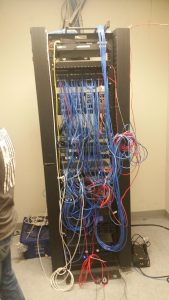Too often, when enterprise network providers suggest upgrading one, some or all components that make up a decaying network infrastructure, the customer will hesitate, because the network still operates, even if not at a high level. The thing is, as is the case with anything in life, many folks have been groomed to not fix what isn’t broken.
 Taking critical funding that is typically allocated for other strategic initiatives, to upgrade an enterprise network – something that isn’t as easy as purchasing a product and turning it on – is a daunting idea for many. Wireless network infrastructure at-large, for many companies is comparable to the “plumbing” in the building; it’s necessary to install, but once installed, the layperson sees it as only worthy of concern when the pipes, fixtures and appliances connected to them give them fits. In the case of a wireless network, most organizations neglect to make changes until someone comes along with a heavy IT background to say they need to be made. Or worse, actions are taken too late, usually after failures occur that end up costing the business revenue. In both cases, the costs associated with eliminating existing problems usually exceed the preventative upgrades or maintenance tasks that would eliminate many. If you have ever had an air conditioner or water heater go offline at your home, you know this too well.
Taking critical funding that is typically allocated for other strategic initiatives, to upgrade an enterprise network – something that isn’t as easy as purchasing a product and turning it on – is a daunting idea for many. Wireless network infrastructure at-large, for many companies is comparable to the “plumbing” in the building; it’s necessary to install, but once installed, the layperson sees it as only worthy of concern when the pipes, fixtures and appliances connected to them give them fits. In the case of a wireless network, most organizations neglect to make changes until someone comes along with a heavy IT background to say they need to be made. Or worse, actions are taken too late, usually after failures occur that end up costing the business revenue. In both cases, the costs associated with eliminating existing problems usually exceed the preventative upgrades or maintenance tasks that would eliminate many. If you have ever had an air conditioner or water heater go offline at your home, you know this too well.
To truly know when the time is right to refresh an enterprise’s wireless network, there’s many more important questions to answer than if it simply functions. After all you’re going to invest your internal IT support, budget and time to get it right the first time, which in itself will almost always require qualified outside help to get you across the finish line. The thing is, do you know what “excellent” looks like for enterprise-class networks in the first place? Here’s some tips and factors to consider for when to take action:
Wired Network Flaws and/or Wireless Network Infrastructure Problems are Slowing Down and Hurting Production Processes. In Short, Revenues Might Suffer.

Uncategorized, messy wiring, combined with disorganized rack hardware is a more simple, physical indicator that the age and condition of your network makes it due for a refresh. After all, it must have taken some time to get to that state. How behind is your network, compared to today’s performance standards and the general specs that more modern systems provide?
This is clearly the #1 “reactive” reason to investigate your next move – your network is now costing you money. Any manufacturer or value-added reseller that provides the hardware and/or takes on a network installation project would like to tell you that their products and services will last for centuries. Simply put, even the leading brands, whether consumer-grade or enterprise-strength cannot fully guarantee what lies ahead for your network, beside applying warranties and promises that they will handle your support requests the best way they can, within terms of purchase.
Think about the revolution taking place on manufacturing plant floors across the country. More machinery today relies on a wireless network connection than in any time in history. Automation itself is fueled by WiFi, as are the mobile and desktop devices that personnel rely on to improve communication and data collection efforts across large work facilities. Consequently, everything that relies on the network is put in jeopardy and operations become fragmented across departments.
Behind many industrial-type organizations are centralized management software applications, whether one or multiple that act as the “glue” to keep all employees and site operations working in harmony. Warehouse management systems are a great example of this, which act to track and manage the movements of people, products and supply chain processes, including retail sales in some cases. They are virtually useless to an organization if they are unable to connect online to the day-to-day processes in motion.
If your enterprise’s network infrastructure cannot support every activity taking place within your four walls, opportunities to grow the business will continue to be missed, and the trickle down effect might even be worse.
Communication and Collaboration Breakdowns Between Teams is Occuring Often. The Enterprise Network Infrastructure, to Blame.
The rise of the Internet made the world smaller. From a business perspective, network connectivity within the four walls of companies today bridges the gaps in communication that workforces have, in regards to information sharing.
Sure, there were walkie talkies and landline phones early on in the modern era, but from the very small tasks that involved pen and paper, to making simple requests and work orders, the Internet of Things has found ways to optimize the way we work together by eliminating steps in workflows through workforce specific applications. Mailworkers, secretaries and interns notoriously were the heartbeat of inter-departmental messages for one thing. “Screensharing”, an advancement resulting from the desire to help employees collaborating on documents together in real-time, is just one of the many things we may even take advantage of today, whereas the term all but didn’t exist a decade ago. Further, as software was previously mentioned, enterprise platforms that gather information and automate work tasks are virtually another communication portal for all employees. The full visibility they provide on current business analytics, from shop floor production and warehousing to even retail sales and marketing have changed the idea of what work is fundamentally. In effect, workforce software has taken the place of many previous tools and functions of yesterday. The sidebar instant messaging options and Intranet outbound calling access they allow for, is only the icing on the cake.
Businesses are composed of many facets, but ultimately are built on people – not cell phones, rugged mobile devices, PC’s or software. These tech pieces are merely a medium for which the real work gets done through. Without a stable wireless network interlocking the web of technology and employees together, most modern business would be slowed to a crawl. The nightmares of retailers during Black Friday in recent years, due to a combination of server issues and site downtimes costing millions of dollars of potential lost profits, is all the empirical evidence you need.
Think about the things you are accustomed to getting done at a fairly efficient rate that all depend on a wireless network – what’s your backup plan and how can you even rely on it in the long term? To add, the trickle down effect to a broken chain of communication can get to the customer in a wide variety of ways. Glaring examples include the customer’s ability to acquire real-time product and service information through web portals and e-commerce platforms to simple transactional message sharing between the consumer and the company.
Network Security Concerns Have Become Paramount. Data Breaches, the Worst Case End Result, are a Real Threat.
It’s often been said that the criminal evolves a step behind the roadblocks set in front of them. The cat and mouse game that takes place everyday between black hat hackers, small and corporate business alike is a very real state of play. News stories exist across every state that call out system breaches, data leaks, and malicious attacks that affect both at the business and consumer level. Most companies today are very concerned in the areas of network security that they can control. The problem is, vulnerabilities still exist for many organizations who haven’t done a comprehensive analysis of what needs to be “locked down”.
Your network is the front line to virtual access. Even if every IoT-ready device was moved into an offline state, the fact that they are reachable remotely remains.

-There are 24,000 malicious mobile apps blocked every day (Symantec)
-21 Percent of all files are not protected in any way (Varonis)
-Ransomware damage costs will rise to $11.5 billion in 2019, with an attack happening every 14 seconds (Cybersecurity ventures)
https://www.varonis.com/blog/cybersecurity-statistics/
A motivated, skilled hacker can find their way into almost anything. A company that doesn’t stress about where opportunities may lie are only opening themselves up for the possibility, even if they think their assets are not worth the trouble. Information, in many cases can be more valuable than any direct deposit of funds an individual can route from an organization – keep this in mind.
How would an update help? Older protocols, software and firmware need constant updating and patches to stay abreast on new alerts. Sometimes, rack hardware, such as firewalls also need to be replaced, as over time the longer certain devices stay in service, the more experience hackers will have with navigating around them. This also goes for wireless access points. If it’s been awhile since you have taken drastic measures to protect your business and are relying more on manufacturer updates vs large scale changes, you may want to consider refreshing the entire network at large as you take on this step.
The Takeaway – Follow a Proactive 1, 3 & 5 Year Wired and Wireless Network Evaluation Schedule.
This isn’t a warning shot, or an alarm, but if you keep an active plan in place, then you can avoid this issues we just presented. First, enterprise networks are no different than any other popular technology, in that it evolves constantly. It’s hard enough for a network services provider to keep up with the topics and trends that matter.

Consistent updates to your network are critical – from small system patches to hardware replacements. Equally important, know the threats your business faces from not making them and bring in an expert to help understand what “latest and greatest” technology can do for you. Though being pitched during an exploratory stage may not be desirable, a provider can shed light on the topics and trends you may not have time to invest in, all for free.
For that reason, it’s suggested to do an annual audit on the performance of the enterprise’s network, outside of tracking daily and weekly reports that are available through your technology’s firmware (or any 3rd party apps you may have at your disposal). After 3 years, a formal network site survey is suggested, which would include a RF spectrum analysis. Within 5 years, depending on the type of industry and the demands put on the wireless network in questions, a full device by device site walkthrough with a network services provider is suggested, as you may be due for an upgrade if you haven’t replaced components of your network infrastructure already.
In all of these steps, the end user can determine when to escalate conversations with outside help to understand what the “latest and greatest” in the enterprise network industry are at the moment. After all, you want to “future-proof” your network as much as possible.
______________
As you can see, with so much riding on the capabilities of your network, it’s surprising that an average network can be tolerated by so many companies worldwide. Take that, in some ways as a competitive advantage you can follow up on.
